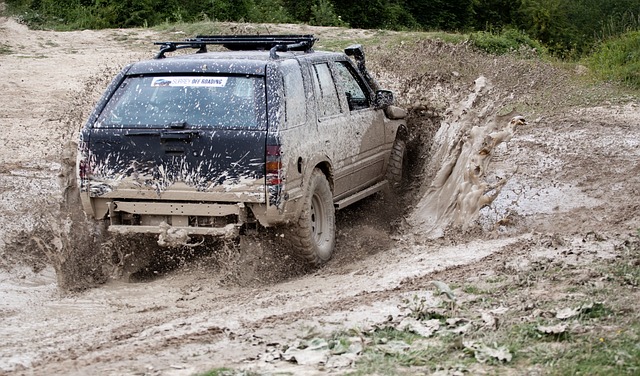Truck skid plates are essential accessories for off-road vehicles, providing protection against terrain hazards like rocks and roots. They come in various materials and designs, with steel being robust for rough terrains and aluminum lighter for mud crossings. Proper installation and regular maintenance are key to ensuring their effectiveness. 4×4-repair-rgv (4×4 repair in the Rio Grande Valley) enthusiasts benefit from these plates for enhanced performance and reduced vehicle damage during challenging off-road excursions, making them a critical component for navigating diverse terrain safely.
“Unleash your truck’s off-road potential with truck skid plates—essential add-ons for any 4×4 enthusiast. This comprehensive guide, tailored for 4×4-repair-rgv enthusiasts, delves into the world of skid plates, offering a basic understanding and exploring their crucial role in enhancing traction and protection. From diverse types suitable for various terrains to installation tips and common issue solutions, this article equips you with knowledge to choose and maintain the perfect skid plate for your rig.”
- Understanding Truck Skid Plates: A Basic Guide
- The Role of Skid Plates in 4×4 Vehicles
- Types of Skid Plates and Their Applications
- Installation and Maintenance Tips for Skid Plates
- Common Issues and Repairs for Truck Skid Plates
- Choosing the Right Skid Plate for Your 4×4-Repair-RGV
Understanding Truck Skid Plates: A Basic Guide

Truck skid plates are an essential component for off-road vehicles, including 4x4s. They serve as a protective barrier at the underside of the truck, providing a crucial defense against obstacles and rough terrains. By mounting them to the frame or chassis, these plates help to prevent damage to more vulnerable parts of the vehicle, such as the drivetrain and fuel tank. This is especially important when navigating challenging 4×4-repair-rv routes where rocks, roots, and other debris can cause significant harm.
Skid plates come in various materials and designs, each offering unique advantages. Typically made from durable steel or aluminum, they are engineered to withstand the rigors of off-roading while also being lightweight to enhance performance. Their installation involves precise alignment to ensure optimal protection without compromising the vehicle’s ground clearance or geometry. Understanding these features and benefits is key for any 4×4 enthusiast looking to maximize their truck’s potential on diverse terrains.
The Role of Skid Plates in 4×4 Vehicles

In the world of off-road adventures, 4×4 vehicles are renowned for their capability and resilience. One crucial component that enhances these capabilities is the skid plate—a sturdy metal shield attached beneath the vehicle. These plates play a vital role in protecting the underbody from obstacles, rocks, roots, and other hazards commonly encountered during rugged terrain navigation. By providing an extra layer of defense, they enable 4×4 owners to explore without worrying about costly repairs or damage.
When it comes to 4×4-repair-rgv (4×4 repair in the Rio Grande Valley), skid plates are a key consideration. They not only safeguard essential components like differential and transfer cases but also contribute to better ground clearance, allowing the vehicle to negotiate challenging trails with reduced risk of getting stuck or sustaining damage. This simple yet effective modification is a game-changer for those who frequently embark on adventurous off-road excursions.
Types of Skid Plates and Their Applications

Skid plates, also known as diff guards or skids, are essential components for off-road vehicles, including trucks. They come in various types designed for specific applications and terrains. One common type is the steel plate, renowned for its durability and protection against rocks, roots, and other obstacles. Often used in rugged 4×4 repairs RGV (Red River Valley), these plates are a popular choice for serious off-roaders due to their robust nature.
Another variety includes poly plastic skid plates, which offer lightweight protection without compromising strength. Ideal for moderate trail use, they’re a smart option for those seeking reduced weight and a lower center of gravity. These plates are versatile and can be easily installed, making them a popular choice among 4×4 enthusiasts in the RGV looking to enhance their vehicle’s capabilities without extensive modifications.
Installation and Maintenance Tips for Skid Plates

Skid plates, a staple in 4×4 repairs RGV, are an essential component for off-road vehicles. Installation involves strategically mounting them under the vehicle’s framework to protect against rock strikes and debris, which is particularly crucial when navigating rough terrain. Ensure proper alignment with the vehicle’s frame and secure fastening using high-quality bolts to prevent displacement during intense drives.
Regular maintenance is key to preserving skid plates’ effectiveness. Inspect for signs of wear, corrosion, or damage, especially after extreme off-road adventures. Cleaning with a suitable degreaser removes dirt and grime, preventing rust buildup. Reapply protective coatings periodically, as recommended by the manufacturer, to shield against environmental factors. Remember, well-maintained skid plates contribute significantly to your 4×4’s overall durability and performance in challenging RGV terrains.
Common Issues and Repairs for Truck Skid Plates

Truck skid plates, an essential component for off-road vehicles, often face various issues due to rugged terrain and extreme conditions. Common problems include dents, cracks, and fractures caused by sharp rocks, roots, or uneven ground. These damages can compromise the plate’s integrity, affecting the truck’s overall stability and performance. In cases of severe damage, 4×4-repair-rgv services are crucial for restoring functionality.
Repairs typically involve replacing the damaged skid plate with a new one, ensuring proper alignment and mounting. Skilled technicians use specialized tools and techniques to ensure a secure fit, enhancing the truck’s off-road capabilities once again. Regular inspection and maintenance are vital to prevent such issues, especially in challenging 4×4 environments where the skid plate plays a pivotal role in protecting the underbody from potential hazards.
Choosing the Right Skid Plate for Your 4×4-Repair-RGV

When selecting a skid plate for your 4×4-repair-RGV, several factors come into play. The primary consideration is the terrain you’ll be navigating—rocky, sandy, or muddy trails demand different materials and designs. For rugged off-road conditions, opt for sturdy steel plates with aggressive patterns to bite into the ground and prevent slipping. If your 4×4 frequently tackles mud and water crossings, a lightweight aluminum plate might be preferable, offering sufficient protection without adding excessive weight.
Additionally, ensure the skid plate fits your vehicle’s underbody perfectly. Improperly sized or fitted plates can hinder ground clearance, potentially causing damage to other components during intense off-roading. Consider custom options if standard sizes don’t align with your 4×4-repair-RGV’s unique shape and needs.
Truck skid plates are essential components for 4×4 enthusiasts, offering enhanced protection and improved performance off-road. By understanding their functions and choosing the right type for your 4×4-repair-RGV needs, you can navigate rough terrains with confidence. Regular maintenance and prompt repairs for any issues will ensure these sturdy plates continue to safeguard your vehicle, making them a valuable investment for adventurous souls on the trail.



